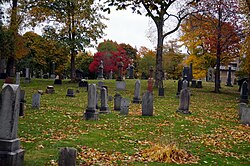Fairview Lawn Cemetery
| Fairview Cemetery | |
|---|---|
 The cemetery in November 2015 | |
 | |
| Details | |
| Established | 1893 |
| Location | |
| Country | Canada |
| Coordinates | 44°39′40″N 63°37′19″W / 44.661°N 63.622°W |
| Type | Public |
| Size | ? |
| No. of graves | ? |
Fairview Cemetery is a cemetery in
Location
Fairview Lawn Cemetery is located in the
History
A
Titanic victims
Fairview was selected by city coroner/registrar John Henry Barnstead as the site where the Titanic victims should be buried.[2]
One hundred and twenty-one victims of the RMS Titanic sinking are interred at Fairview, more than any other cemetery in the world. Most of them are memorialized with small gray granite markers with the name and date of death. Some families paid for larger markers with more inscriptions. The occupants of a third of the graves, however, have never been identified and their markers contain just the date of death and marker number. Surveyor E. W. Christie laid out three long lines of graves in gentle curves following the contours of the sloping site. By co-incidence, the curved shape suggests the outline of the bow of a ship.[3] A complete listing of those victims buried in Fairview can be found here.
One of the better-known Titanic markers is for an unidentified child victim, known for decades as
A grave marked "J. Dawson" gained fame following the release of the 1997 film Titanic, since the name of Leonardo DiCaprio's character in the film is Jack Dawson. Many filmgoers, moved by the story, left flowers and ticket stubs at Dawson's grave when the film was first released, and flowers continue to be left today. Film director James Cameron has said the character's name was not in fact inspired by the grave. More recent research has revealed that the grave actually belongs to Joseph Dawson, an Irishman who worked in Titanic's boiler room as a coal trimmer.[5]
The Fairview Titanic graves also include the burial place and marker of
Twenty-nine other Titanic victims are buried elsewhere in Halifax; nineteen in the
War Graves
The cemetery also contains 29 war graves of Commonwealth service personnel, 20 from World War I and 9 from World War II.[7]
References
- ^ Ruffman, Alan Titanic Remembered: The Unsinkable ship and Halifax (1999) Halifax: Formac Publishing
- ^ Titanic: The Aftermath, Discovery Channel
- ^ Beed, Blair Titanic Victims in Halifax Graveyards (2001) Halifax: Dtours, page 89.
- ^ "Canadians identify child aboard Titanic - USATODAY.com". www.usatoday.com.
- ^ *"The Real Jack Dawson", Encyclopedia Titanica
- Montreal Gazette. p. 1. Retrieved September 21, 2020.
- ^ [1] CWGC Cemetery Report.
